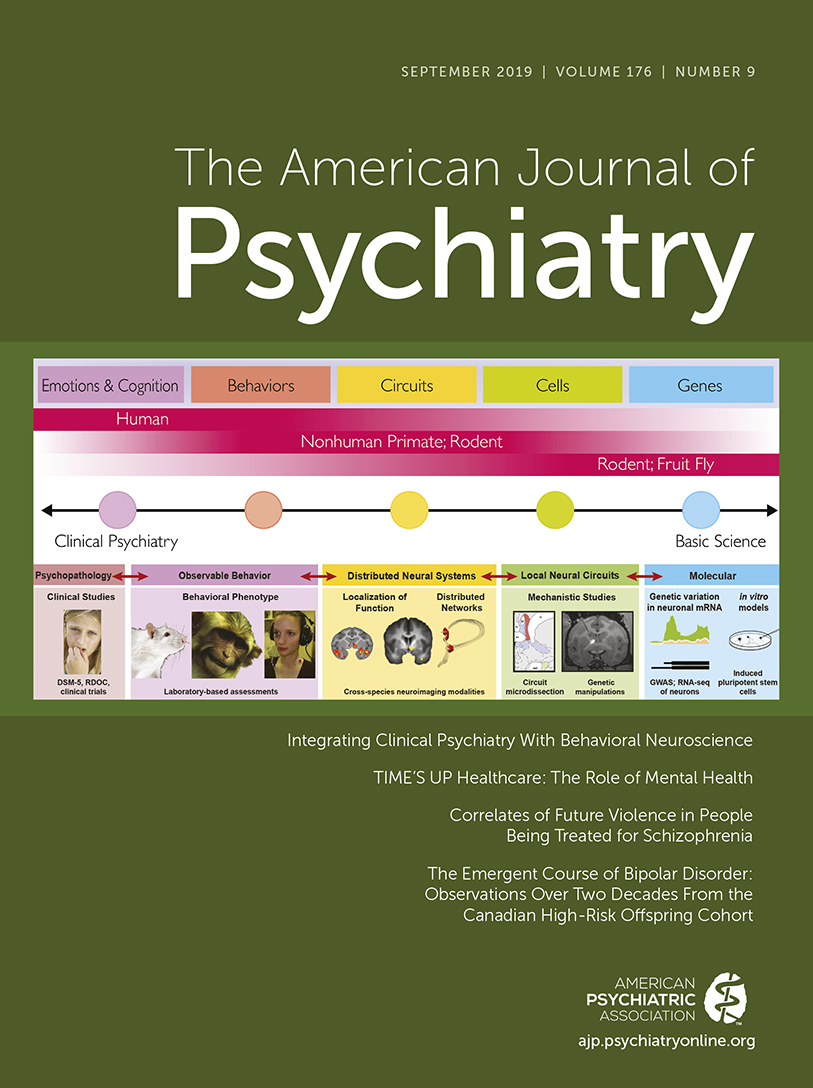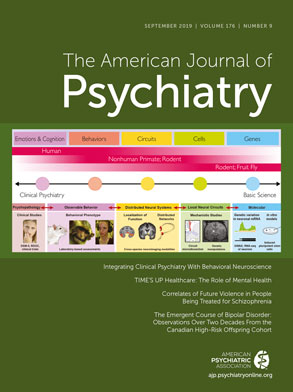This issue of the
Journal includes an important study by Zou and colleagues (
1) examining the relationships of prenatal and postnatal (2 months, 3 years, and 10 years) maternal depression with gray and white matter brain metrics and behavior in offspring in preadolescence. In a large population-based sample, the authors found that maternal depression in the postnatal period (at child age 2 months) was associated with overall reduced offspring gray matter volumes and reduced fractional anisotropy (a measure of white matter integrity) in the forceps minor, a white matter tract connecting the frontal lobes, at age 10. Furthermore, a trajectory of elevated maternal depression across the child’s development to preadolescence was associated with reduced gray and white matter volumes, as well as reduced fractional anisotropy in the forceps minor and major (connecting the occipital lobes) and the uncinate fasciculus, a white matter tract connecting limbic structures such as the amygdala and hippocampus to the orbital frontal cortex. Zou et al. also found that gray matter volume mediated the relationship between maternal depression in the postnatal period and child attentional challenges at age 10.
This work contributes to a growing body of literature demonstrating that maternal depression is related to disruptions in multiple aspects of child development, including brain (e.g.,
2–
6), behavior (
7–
9), immune function (
8,
10,
11), and hypothalamic-pituitary-adrenal function (
10). The study goes beyond previous work in attempting to identify whether there are sensitive periods for maternal depression in terms of relationships to offspring brain development. When the authors examined associations with each assessment time point separately (i.e., prenatal, 2 months postnatal, age 3, and age 10), they found evidence suggesting that maternal depression in the early postnatal period showed particularly strong relationships with offspring brain structure at age 10. The authors also report that maternal depression during pregnancy, measured in the middle of pregnancy, had the highest correlation with early postnatal maternal depression. Thus, it is possible that elevated depression during the latter half of pregnancy, which was not measured, may also have contributed to alterations in offspring brain structure. Studies that longitudinally assess offspring brain development beginning at birth along with measures of maternal depression throughout pregnancy can help to further clarify the relative prenatal and postnatal influences.
The authors also raise the possibility that the severity of maternal depression in the postnatal period may be a marker for overall increased maternal depression across offspring development, as the mothers with high depression at this early postnatal period also showed elevated depression across all four periods assessed. Consistent with this hypothesis, Zou et al. used latent class analyses to identify women with different trajectories of depression, and found that a trajectory characterized by a pattern of overall elevated maternal depression across a child’s development was associated with reduced brain volumes, and more so than a trajectory characterized by elevated maternal depression that occurred only later in the child’s development. This finding contrasts, to some extent, with previous work, which has not found consistently strong effects of elevated trajectories of maternal depression on offspring brain structure (
4) or behavior (
12).
What the authors did not find in the study is, in many ways, as striking and important as what they did find. First, Zou et al. conducted analyses with statistical models that did and did not include covariates representing potential confounders that have their own effects on brain development and behavior, including maternal education level, smoking, alcohol use, and household income. These variables themselves can be risk factors for both maternal and child depression and have been associated with differences in brain development. When the authors did not control for these covariates, they found much more extensive evidence for relationships between offspring gray and white matter brain structure and maternal depression measured at every time point, ranging from the prenatal period to preadolescence. Once they added covariates, however, all of these relationships disappeared, other than for postnatal maternal depression. Zou et al. did not determine which of the covariates accounted for the variance otherwise associated with maternal depression, and thus we do not know whether it was the measures of maternal socioeconomic status and/or maternal substance use that were the key predictors and whether this varied across childhood. However, this pattern of results is highly consistent with work showing that early exposure to poverty and adversity is associated with alterations in both gray and white matter structure (
13,
14). Previous studies examining the relationship between maternal depression and offspring brain development have varied in the degree to which they have accounted for such confounders. A number of previous studies have carefully controlled for factors such as maternal education and family income and still have found associations with behavior (e.g.,
7) and/or brain (e.g.,
2,
3), but others have not (e.g.,
4), and many studies have not accounted for maternal substance use (e.g.,
2,
3,
7). Thus, Zou and colleagues’ findings suggest the possibility that some previous data linking maternal depression to child outcomes may reflect early poverty or maternal substance use.
Second, Zou et al. primarily found effects in overall measures of gray and white matter brain volumes and a few specific white matter tracts but did not find any effects on the amygdala, the hippocampus, or other subcortical regions. A number of previous studies have found various differences in amygdala or hippocampal volumes, white matter integrity, connectivity, or task-related brain activity, although the results have been highly variable across studies. The variability in findings in the amygdala and hippocampus in relationship to maternal depression contrasts with the arguably more consistent findings linking early poverty and adversity to altered amygdala and hippocampal volumes (e.g.,
15–
17).
There may be important clues as to common mechanisms by which interrelated factors such as depression, poverty, and adversity influence child development. For example, it has been argued that both maternal depression (e.g.,
11) and poverty (
18) contribute to disrupted brain development in children through engendering a proinflammatory phenotype, which may begin in utero and which can have long-lasting effects on both physical and mental health in children. Alternatively (or in addition), Zou et al. point to the possibility that the observed maternal depression effects are mediated by alterations in maternal caregiving that may begin during infancy and that can have long-lasting effects on child development. Other research also suggests that the relationship of poverty with child development is mediated at least in part through disrupted caregiving behavior (e.g.,
15) and that supportive parenting may buffer the negative impact of low socioeconomic status (e.g.,
19–
22). The findings of Zou et al. extend the literature on the relationship of maternal depression to child brain and behavioral development, highlighting the early postnatal period as potentially having a particularly important impact. Taken together with the extant research on maternal depression, poverty, and early adversity, these results also suggest the need to consider the many other factors that are often correlated with maternal depression, which can have their own impact on child development. It is critical to try to understand these interrelationships and their causal pathways given the need to design interventions—which may need to begin as early as pregnancy—that address the core drivers of child development and mental health. Admittedly, these factors are often difficult to tease apart and may be inextricably linked in some contexts, which must be considered when developing targeted strategies to improve child outcomes.

